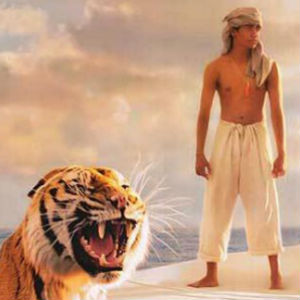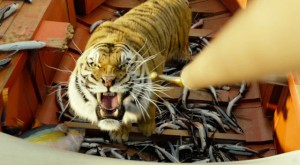Film Review: “Life of Pi” — A Spectacular 3-D Fable for Our Times
Sophistocates may recoil at the deliberate symbolism and guileless self-assurance of Life of Pi. But this is a fable of storytelling, faith, spirituality, and coming of age whose sympathies are clear and strong, couched in visuals of such extraordinary artistry that the experience of watching it is intoxicating.
Life of Pi. Directed by Ang Lee. At cinemas throughout New England.
By Tim Jackson
I can’t say that movies in 3-D offer, for this audience member, a compelling reason to choose one film over another, but in the right hands and with a compelling idea, the combo can make great art. Martin Scorsese’s Hugo is a magnificent love letter to movie history; Wim Wender’s Pina makes adroit use of exotic landscapes and theater spaces to picture Pina Bausch’s elemental and expressionistic choreography; Werner Herzog’s Cave of Forgotten Dreams explores the shapes and textures of man’s earliest paintings in the Chauvet-Pont-d’Arc Caves and, of course, James Cameron’s Avatar pioneered the 3-D art form with a wholly invented world of fantasy and metaphor. Now Ang Lee has committed his gifts as a director to bringing Yann Martel’s Life of Pi into 3-D, seamlessly blending live actors with a computer-generated (CGI) menagerie of perfectly rendered beasts and astonishing landscapes.
Lee is a director of integrity and skill who effortlessly crosses genres, creating films that can be intimate or spectacular. Life of Pi is both. His track record as a director indicates that he could meet the challenge of bringing this difficult novel to the screen, and in 3-D. With the 1993 gay comedy The Wedding Banquet and the family comedy Eat Drink Man Woman in 1994, Lee explored his own Taiwanese culture and mores, showing his skill at blending drama with comedy. He jumped into British costume drama with Sense and Sensibility, American suburban dysfunction with the heartbreaking Ice Storm, and the American western via Ride the Devil. He took a shot at the superhero genre with Hulk and missed and then blew everybody away with his epic Crouching Tiger Hidden Dragon, which grossed over $250,000,000. He returned to the theme of gay love and human relationships (winning an Academy Award for Best Director) with the powerful Brokeback Mountain. He followed that up with a sexy, steamy, noir drama, Lust, Caution and took a nostalgic look at America in the 1960s with Taking Woodstock, a rare (because successful) attempt to evoke the spirit of that age on celluloid.
With Life of Pi, the director’s skill at creating striking and elaborate visual compositions literally takes on another dimension. The story is in two parts, narrated by way of the recollections of the older Pi (played by familiar Indian actor Irrfan Kahn). He recalls to an interviewer (Rafe Spall) how he grew up in Pondicherry, India where his father owned a zoo. As a boy, he was a seeker who looked for life’s meaning through various religions, first his native Hindu, then Catholicism, and finally Islam. When his family finds it necessary for political reasons to leave India, selected animals are packed up to sell in their new home, Canada. The second part follows the sea voyage, where an enormous storm takes the lives of all on board leaving only Pi alive with a zebra, a hyena, an orangutan, and a Bengal tiger named Richard Parker. Most of the film takes place in Pi’s 26-foot-long lifeboat, the protagonist’s survival depending on his guile and faith for nearly a year at sea. After some initial battles and bloodshed, Pi must come to terms with the wild creatures as they vie for territory, supremacy, and, ultimately, mutual survival. This is no anthropomorphized tiger we see, but a beast of chillingly realistic movement and detail.
Sophisticates may recoil at the deliberate symbolism and guileless self-assurance of Life of Pi. But this is a fable of storytelling, faith, spirituality, and coming of age whose sympathies are clear and strong, couched in visuals of such extraordinary artistry that in the hands of this master director makes for intoxicating viewing.
Lee’s talent for working with actors is evident in the commitment and ease with which newcomer Suraj Sharma approaches what would have been an enormously difficult challenge for any actor. As Sharma explains it, “Three months before shooting (Lee) trained me. In a million different fields. Basically, everyday in every way, he’d build a little bit of Pi in my head. Little by little there were blocks and blocks and blocks. By the end of it, I felt Pi was part of me.” The blend of live acting and CGI animation is nothing short of miraculous. Computer generated animals have for some time now been remarkable (think of Robin Williams in Jumanji), but in this film, Sharma is alone on open sea in a single location: most of it simulated in a 1.7-million-gallon water tank in Taiwan. The levels of reality are seamlessly blended in Sharma’s performance. The animals are headlined by the miraculous tiger, whose body sways to the motion of the boat with eyes that stare directly out at the viewer. The creature leaps into and swims through the water, catching silvery, flying fish by smacking then down with its quick paw.
Throughout the film, Lee finds ingenious compositions that are stunning in 3-D. The subtle and quiet use of three dimensions in the first part of the film gives way to a powerful typhoon, with water flooding the screen (seemingly pouring into our laps), animals swimming on and beneath its surface. As Pi drifts through the days and nights at sea, we find ourselves looking at a myriad of surfaces and spectacles. Often Lee places the viewer deep under the surface of the ocean with its variety of aquatic wildlife. When creatures swim to surface, we gaze into the sky. One remarkable sequence involves hundreds of slithery, shining, flying fish soaring over the boat, landing, squirming, and colliding with Pi and Richard Parker, ultimately providing food. In another moment, the sea lights up at night with a vast spectacle of florescent jellyfish, the latter illuminating the ocean from underneath while the reflections of the stars shine on the surface. The earth and the universe become one.
Avatar was rich with allegories about rain forest destruction, the genocide of native people, post-colonialism, and the spoiling of the natural world. Set in a fantastical landscape, it eventually morphed into an action picture. Frankly, I am worn out by the heavy-duty descendants of Avatar, the new genre of “cosmic” special effects stories like Inception or Cloud Atlas. Pi stays simple. Its brilliant effects and design are at the service of a clear, spiritual message that eschews the didactic. In Lee’s own words, “Something as an artist and storyteller, I deeply appreciate . . . is the power of storytelling in relationship to God and how that brought meaning to life and how it brings us together.”
Lee’s simplicity makes Pi a risky picture: it cost 120 million dollars, has no known stars, and took four years to make. I recommend grabbing a pair of 3-D glasses and seeing it while you can. You will revel in the spectacle and may be moved by its sincerity.



I thought this movie was going to be boring and predictable. I walked out of the theater with a completely different opinion. This movie definitely grabbed me and that’s rare for a movie these days. I can’t wait to see it again! I’ve already added Life of Pi to my queue on Blockbuster @Home from DISH, so as soon as it’s available on Blu-Ray, I won’t have to scope it out at the store. I saw it with one of my DISH coworkers and we would recommend seeing it for sure.